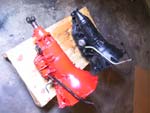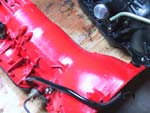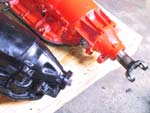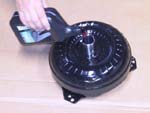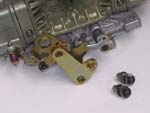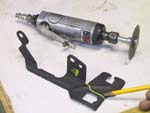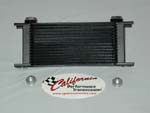
 |
 |
| Overdriveability | |
| Bolt a TH200-4R Into Your Musclecar By Tony Nausieda photographer: Tony Nausieda The concept of an Overdrive gear--a ratio numerically lower than 1:1--is hardly high-tech, but nevertheless, it wasn't often a part of passenger-car transmissions until the mid '80s. That puts the overdrive era well out of the prime musclecar years, but that doesn't mean it's out of reach. It should come as no surprise to CHP readers that certain overdrive transmissions can be retrofitted into classic Chevy muscle without much fuss. But that wasn't enough for us--we wanted a true bolt-in swap, as the thought of "clearancing" the floorpan on our mostly original '70 Chevelle SS 396 really turned our stomachs. But the Turbo 400 and 3.73:1 gears were killing our freeway prowess, so we did a little research and found that a TH200-4R trans would bolt right into place. The bad news, though, was the simple fact that a stock TH200-4R trans--excluding relatively scarce Monte SS or Turbo Regal variants, would be a ticking time bomb behind the Chevelle's torquey oval-port 402. Don't fret--recognizing the TH200-4R's bolt-in appeal, the performance aftermarket has re-engineered nearly all of this transmission's weak points to make it live behind a far more serious powerplant than Grandma's 307 Cutlass. Art Carr's High Tech valvebody kit was one of the pioneering speed mods for this trans, and years of development and racing have netted a slew of beefy TH200-4R internals that are presently available through Carr's new company, California Performance Transmission (CPT). After hearing of 9-second turbo Buicks running the CPT TH200-4R, we figured it was reasonable to expect one of these gearboxes to live happily behind our baby big-block. CPT's Steve Lancaster explained to us the inadequacies of GM's design and how they've been improved upon in the Extreme Duty TH200-4R. Probably the most failure-prone element of a stocker TH200-4R is the intermediate drum and stator support. Even in mild 300hp applications, CPT has seen the splines shear off the shaft. A Kolene coil-induction heat-treating operation allows CPT's drums to safely withstand loads approaching three times that of the original. Plagued by poor metallurgy, the splines on the stator support wear out fast, and many of the junkyard cores we've seen have knife-edged (at best) or nearly smooth splined areas. CPT's stator support has been heat-treated to give a harder surface condition, which ensures the splines will survive. With the factory's metallurgical mistakes fixed, the next improvements are made in the clutches and band. A common complaint with the TH200-4R is premature failure of the direct clutch pack and overdrive. CPT has added additional frictions with Kolene-treated steels to the direct clutch pack, upping the total ante to eight. The overdrive torque-holding capacity is bolstered to give a total of three frictions with Kolene steels. Carr boldly states, "This has cured the problem." The stock grooved 1-2 band is pulled in favor of a fully lined, high-performance friction band that can provide more clamping force. CPT's billet Super Servo has a larger apply area and ensures slip-free band application and a crisp 1-2 shift. Naturally, this does positive things for band life, too. How a transmission regulates fluid is a critical part of its strength and how it's going to behave when installed. A 10-vane pump is employed to provide a steadier, more consistent pressure level than the stocker 7-vane pump. Kolene heat-treating on the vanes and hardened pump rings allow high line pressures--240 to 270 psi at wide-open throttle (WOT)--that give CPT units extremely positive clutch and band engagement. With all the buzz about BRF-code valvebodies (originally installed in some Buick Grand Nationals), the prices have just about gone through the roof on good cores. CPT's Hi-Tech valvebody kit virtually emulates a competition-prepped BRF valvebody when installed in a common non-performance valvebody (like the one in your great-aunt's Monte). Both lockup and nonlockup kits are available. We chose the nonlockup version--the lockup clutch is kinder to the trans fluid at highway speeds, but Carr advocates removing the lockup function for best performance. Citing the performance gains found in clients' Turbo Buicks, we figured a big-block Chevelle would benefit similarly. Carr estimated we'd give up about 100-200 rpm on the freeway, but the 0.67:1-geared Overdrive meant the 402 would still spin under three grand, deep into the comfortable cruising zone. The minimal rpm drop has a lot to do with the efficient CPT converter supplied with our trans. Carr has been building some of the best and most efficient torque converters for decades, so we trusted his advice when he recommended a 10-inch piece for our Chevelle. Each is custom-built to the customer's specific application, so we gave our cam specs (Comp 280H), compression (10.25:1), heads (stock closed-chamber oval ports), and gearing (3.73), and CPT built the converter to stall slightly under 3,000 rpm (ours flashes to about 2,800). CPT also offers a 9/11 high-performance lockup converter equipped with a severe-duty lockup clutch should you want to retain this feature. It should save you time to install the converter on the new trans before it's under the car; sometimes it's tricky to get properly clicked into place if you don't have much room to work. Prime the converter with 1.5 quarts of Dexron III ATF. Turn the converter slowly and apply a slight pushing force while gently jiggling it up and down until you feel three distinct clicks. Properly installed, the converter bolt flange will be inset about 11/8 inch from the end of the case. Improperly installed, your engine's thrust bearing will die a grinding, painful death, so make sure it's right before you proceed. Yes, installing the TH200-4R in the Chevelle was a pretty simple affair, despite working solo and without the convenience of a fancy lift. We supported each corner of the 'Velle with a big three-ton jackstand adjusted to its maximum height, which gave us enough room to slide the old 400 out from under the car. We had to remove the transmission mount and drop the exhaust system to extract the crossmember. Anticipating clearance issues, we pulled the oil filter and oil-pressure sending unit and removed the Hooker 2-inch-primary Competition headers. A transmission jack really makes things easier when it's time to pull the old trans away from the flexplate and lower it to the ground. In a pinch, you can use a thick (¾-inch) piece of plywood cut slightly larger than the trans pan to distribute the load of a floor jack, but balancing a 100-plus-pound Dexron-hemorrhaging pig precipitously atop a 4-inch cup isn't our idea of a good time. We found it easiest to bolt the TV cable to the trans and install the dipstick sheath before bolting the trans into place. Factory '70 Chevelle fasteners were reused everywhere except to secure the TV cable to the trans (M6x1x20mm) and the converter to the flexplate (M10x1.5x15mm). The converter-to-flexplate bolts were torqued to 35 lb-ft, the case-to-engine bolts to 45 lb-ft, and the TV-cable-retainer bolt to 10 lb-ft. CPT supplied a high-strength polyurethane trans mount; we torqued that to 35 lb-ft and reinstalled the crossmember. If you're converting from a T350, 'Glide, or a pre-'71 Muncie, you'll have to redrill the crossmember mounting holes farther rearward (or cut and reweld the mounting tabs if your frame has boxed side rails). The T400's flexplate cover didn't quite fit, so we liberated a cover from an '86 Monte at the junkyard (GM PN 14073768 if you'd rather buy it new). The factory Chevelle driveshaft worked fine once we replaced the 32-spline slip yoke with a more slender, but longer 27-spline unit. CPT offers a yoke that fits bulletproof 1350-series U-joints, but we kept our stock 1310s as we're not planning to flog this car too hard. The pressure/return cooler line fittings are located slightly farther apart from each other on the TH200-4R; bending the ends of the stock hard lines allowed them to comfortably bolt up. Naturally, CPT recommends installing a trans cooler, but we left that part out of this installation. Under the car, the TH200-4R's wide pan is (somewhat) reminiscent of a Turbo 400, so we feel it doesn't really detract from the car's stock appearance. If we had to characterize one annoyance of the late-model GM overdrives, it's their sensitivity to TV-cable adjustment. Incorrect throttle-arm geometry can wreak serious havoc on the internals of a TH200-4R, dramatically shortening its life span and giving poor driveability. Fortunately, a few parts make it easy to get the geometry dead-on. As shown in an accompanying photo, we bolted up a modified bracket from a 307ci/TH700-R4 '85 Olds Delta 88 to securely retain the snap-in TV-cable sheath. The end of the cable attaches to a stud mounted on the throttle arm of your carb or throttle body. This is where the geometry gets critical--this stud must follow a specific arc as the throttle is applied. The stud must lie at a radius between 1.094 inch and 1.125 inch from the pivot (the centerline of the throttle shaft). Furthermore, when the throttle is cracked about one-quarter open, the stud should lie at the bottom of its circular arc. If these two criteria are met, it's just a matter of lengthening or shortening the cable length to ensure the cable doesn't bottom out before WOT is reached. CPT offers specifically engineered stud fixtures for Edelbrock, Quadrajet, and Holley carbs that ensure dead-on stud geometry. Simply bolt the proper fixture to the throttle arm and the stud is right where it should be--easy. If you want to rig something up yourself, CPT can provide a drawing of the correct geometry. Naturally, we expected the post-install testdrive to highlight a few bugs, but we were pleasantly surprised when the new trans went about its shifty business. Unfortunately, the Chevelle's factory column shifter won't allow manually shift into First gear, but CPT will sell you a conversion kit if you're sporting a factory floor shift. First impression: This is a split-personality gearbox--the shifts are nice and comfy at part throttle, but at WOT, the engine shoots to 5,400 rpm and kicks the car sideways on the 1-2 shift. So this TH200-4R does everything the 400 did, and it keeps us on the fuel-friendly side of 3,000 rpm at any (legal) freeway speed. With the best of both worlds bolted behind our big-block, we're saving the old 400 for a different rainy day--say, a drag-car project. |
|
Home | Parts Catalog | Techincal Info | Media | Testimonials | Contact Us | Warranty Info | Terms | Returns | Pricing | Site Map

